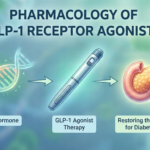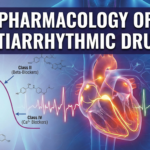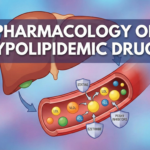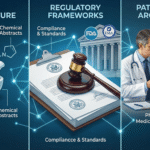Antihypertensive agents form a diverse class of drugs that reduce elevated blood pressure and thereby diminish the risk of major cardiovascular morbidity and mortality, such as stroke, myocardial infarction, heart failure, and chronic kidney disease. Their rational use requires understanding pathophysiology, mechanisms of action, pharmacokinetics and dynamics, clinical indications, adverse events, and individualized selection based on comorbidities and target-organ protection. This chapter draws exclusively from established medical pharmacology textbooks, principally Goodman & Gilman, Katzung, and Rang & Dale.
I. INTRODUCTION AND OVERVIEW
- Hypertension (HTN) is a chronic disorder, attributed to complex interactions of genetic, environmental, and neurohumoral factors. It encompasses primary (essential) and secondary forms, with >90% falling under the former.
- The disease is defined as persistently elevated arterial blood pressure (typically ≥140/90 mmHg, though thresholds evolve based on guidelines).
- Lowering BP is proven to reduce risk of stroke, heart failure, coronary events, and renal failure.
II. PRINCIPLES IN ANTIHYPERTENSIVE THERAPY
Goals:
- Achieve and maintain a target BP (<140/90 mmHg for most; lower for some with diabetes, kidney disease, or high risk).
- Prevent organ damage while minimizing drug-related adverse effects.
General Mechanisms:
- Reduction of cardiac output
- Reduction of systemic vascular resistance
- Modulation of intravascular volume or neurohumoral drive
III. CLASSIFICATION OF ANTIHYPERTENSIVE AGENTS
A. Diuretics
- Thiazide diuretics (hydrochlorothiazide, chlorthalidone)
- Loop diuretics (furosemide, torsemide)
- Potassium-sparing diuretics (spironolactone, eplerenone, amiloride, triamterene)
- Carbonic anhydrase inhibitors (acetazolamide; not routine for HTN)
B. Sympatholytics (antiadrenergic agents)
- Beta-adrenergic blockers (propranolol, metoprolol, atenolol, bisoprolol, nebivolol, carvedilol)
- Alpha-adrenergic blockers (prazosin, doxazosin, terazosin)
- Central sympatholytics (clonidine, methyldopa, guanfacine, moxonidine)
- Presynaptic adrenergic neuron blockers (reserpine, guanethidine; rarely used now)
C. Vasodilators
- Direct-acting vasodilators (hydralazine, minoxidil, sodium nitroprusside: emergency/critical care)
- Calcium channel blockers (dihydropyridines: amlodipine, nifedipine, felodipine; non-dihydropyridines: verapamil, diltiazem)
- Potassium channel openers (minoxidil)
D. Drugs interfering with the Renin–Angiotensin–Aldosterone System (RAAS)
- ACE inhibitors (enalapril, lisinopril, ramipril, perindopril, captopril)
- Angiotensin II receptor blockers (ARBs) (losartan, candesartan, valsartan, olmesartan)
- Direct renin inhibitors (aliskiren)
- Aldosterone antagonists (spironolactone, eplerenone)
E. Others
- Endothelin receptor blockers (experimental)
- Drugs targeting natriuretic peptide clearance
- Combined antihypertensive agents (e.g., ACE inhibitor + diuretic)
- SGLT2 inhibitors: not first-line for BP, but relevant in diabetes patients
IV. PHARMACOLOGICAL CHARACTERISTICS (MECHANISMS)
A. DIURETICS
Thiazides: Inhibit Na⁺Cl⁻ cotransport in distal convoluted tubules, increase excretion of sodium and water, cause volume depletion, decrease cardiac output and after several weeks lower peripheral resistance. First-line agents for uncomplicated hypertension.
Loops: Inhibit Na⁺K⁺2Cl⁻ cotransport in ascending limb of loop of Henle. Used mainly in heart failure, CKD, or volume overload conditions.
Potassium-sparing: Block aldosterone or ENaC. Useful as adjuncts for patients with hypokalemia risk.
B. SYMPATHOLYTICS
Beta-blockers: Block beta-adrenergic receptors (predominantly β1 in the heart), decrease cardiac output, renin secretion, and central sympathetic outflow. Indicated for angina, post-MI, and heart failure.
Alpha-blockers: Block α1-adrenergic receptors in vascular smooth muscle, reduce resistance. Not recommended as monotherapy due to increased risk of heart failure and stroke.
Central agents: Clonidine, methyldopa act as agonists at central α2-adrenergic receptors, decrease sympathetic outflow, with sedation and dry mouth as typical adverse effects.
C. CALCIUM CHANNEL BLOCKERS (CCBs)
Inhibit L-type calcium channels in vascular smooth muscle and myocardium.
- Dihydropyridines mainly reduce systemic vascular resistance
- Non-dihydropyridines (verapamil, diltiazem) decrease heart rate and contractility
Adverse effects: ankle edema, flushing, headache, possible conduction blocks (non-dihydropyridines).
D. VASODILATORS
Hydralazine: Direct arteriolar dilator via nitric oxide, increase HR and renin via reflex, commonly used for severe hypertension in pregnancy. Adverse: lupus-like syndrome at high doses.
Minoxidil: Opens K+ channels causing relaxation; potent, used for resistant hypertension with diuretic/beta-blocker.
Sodium Nitroprusside: IV only; liberates NO; used for hypertensive emergencies. May cause cyanide toxicity with prolonged use.
E. RAAS INTERFERING DRUGS
ACEi: Inhibit angiotensin-converting enzyme; lower Ang II, reduce vasoconstriction, and aldosterone; increase bradykinin (vasodilator).
ARBs: Block AT1 Ang II receptors; similar outcomes to ACEi but less cough/angioedema.
Direct renin inhibitors: Aliskiren blocks conversion of angiotensinogen to Ang I.
Aldosterone antagonists: Spironolactone and eplerenone block mineralocorticoid receptor, sparing potassium.
V. CLINICAL INDICATIONS AND ALGORITHM
- Uncomplicated hypertension: Begin with thiazide, ACEi/ARB, CCB mono- or combination therapy.
- Comorbid situations:
- Diabetes nephropathy: ACEi/ARB preferred
- Post-MI, heart failure: beta-blockers, ACEi/ARB, aldosterone antagonists
- Pregnant: methyldopa, labetalol, hydralazine
- African ancestry: CCB/thiazides more effective
- Chronic kidney disease: ACEi/ARB slow progression
- Elderly: CCBs, thiazides preferred
VI. ADVERSE EFFECTS, CAUTIONS, INTERACTIONS
- Thiazides: Hypokalemia, hyperuricemia, glucose intolerance, dyslipidemia
- Loops: Similar, but more pronounced diuresis and risk of hypokalemia
- Potassium–sparing: Hyperkalemia, especially when combined with ACEi/ARB
- Beta-blockers: Bradycardia, fatigue, bronchospasm, masking hypoglycemia
- Alpha-blockers: Orthostatic hypotension
- CCBs: Edema, headache, AV block with non-dihydropyridines
- ACEi: Cough, angioedema, hyperkalemia, renal dysfunction
- ARBs: Hyperkalemia, lower risk of cough/angioedema
- Central agents: Sedation, dry mouth, rebound hypertension with abrupt withdrawal
- Hydralazine: Tachycardia, lupus syndrome
- Minoxidil: Hirsutism, pericardial effusion
VII. ANTIHYPERTENSIVE COMBINATIONS AND FIXED DOSES
- Fixed-dose combo tablets improve adherence (e.g., ACEi + thiazide, ARB + CCB)
- Must combine drugs with complementary mechanisms and non-overlapping toxicities
VIII. HYPERTENSIVE EMERGENCIES
Drugs: sodium nitroprusside, labetalol, esmolol, nicardipine, hydralazine, clevidipine, phentolamine.
Indications: Severe hypertension with acute organ damage—stroke, dissection, acute kidney injury
IX. PHARMACOKINETICS AND INDIVIDUALIZATION
- Most agents (except IV forms) have oral bioavailability, varying metabolism and renal excretion.
- Genetics (CYP polymorphisms, ACE genotype), comorbidities, polypharmacy require careful dosing.
- Renal, hepatic dysfunction demand adjustment for many—especially beta-blockers, ACEi, ARBs, diuretics.
X. SPECIAL TOPICS
- Resistant hypertension: Defined as uncontrolled BP despite three agents (including diuretic); causes include secondary hypertension, non-adherence, white coat effect.
- Pregnancy: Methyldopa, labetalol, hydralazine safely used; ACEi/ARB contraindicated.
- Pediatric use: Dosing, choice varies markedly; lifestyle modification is always first.
XI. TABLES (CLASSIFICATION AND MECHANISMS)
| Class | Representative Drugs | Main Mechanism | Key Indications |
|---|---|---|---|
| Thiazide diuretics | Hydrochlorothiazide, chlorthalidone | Lower plasma volume, dilate arterioles | Uncomplicated HTN, elderly |
| Loop diuretics | Furosemide, torsemide | Strong volume reduction | Severe HTN, CKD, HF |
| Potassium-sparing diuretics | Spironolactone, amiloride | Retain potassium, block aldosterone | Adjunct |
| ACE inhibitors | Enalapril, lisinopril | Block Ang II generation | Diabetes, CKD, HF, MI |
| ARBs | Losartan, candesartan | Block Ang II receptor | Similar to ACEi |
| CCBs | Amlodipine, verapamil | Disrupt Ca2+ entry, relax vessels | Elderly, isolated systolic |
| Beta-blockers | Metoprolol, bisoprolol, nebivolol | Lower CO, renin, CNS outflow | Post-MI, HF, young adults |
| Alpha-blockers | Prazosin, doxazosin | Block vascular α1 | Resistant/urinary symptoms |
| Central agents | Clonidine, methyldopa | Lower CNS outflow | Pregnancy, special cases |
| Direct vasodilators | Hydralazine, minoxidil | Relax arterioles via NO/K+ | Severe/resistant HTN |
| Class | Main Mechanism | Best Use |
|---|---|---|
| Thiazides | ↓ Blood volume, SVR | Elderly, Black adults, mild HTN |
| Loops | Potent natriuresis | Severe CKD, heart failure |
| ACEi/ARBs | RAAS block | Diabetics, post-MI, CKD, HF |
| Beta-blockers | ↓ HR, CO, renin | Post-MI, heart failure |
| CCBs | Vasodilation, ±HR↓ | Elderly, ISH, Black adults |
| Vasodilators | Arterial Direct relax | Severe/resistant hypertension |
| Aldosterone antags | MR blockade | Resistant HTN, HF, hyperaldosteronism |
| Central agents | ↓ CNS outflow | Special cases (pregnancy, resistant) |
XII. SUMMARY POINTS
- Choice of agent should consider age, comorbidities, indication, cost, and tolerance.
- Lifestyle modification is always first-line; pharmacologic therapy tailored, often using combinations for synergy.
- Therapy aims for target BP, protection from major CV outcomes, minimizing adverse effects and improving quality of life. The number of available agents enables precise choice for each clinical scenario.
REFERENCES
- Brunton LL, Hilal-Dandan R, Knollmann BC, eds. Goodman & Gilman’s The Pharmacological Basis of Therapeutics. 13th ed. New York: McGraw-Hill; 2017. Chapter: Antihypertensive Agents.
- Katzung BG, Trevor AJ, eds. Basic & Clinical Pharmacology. 15–14th ed. New York: McGraw-Hill; 2023. Chapter: Antihypertensive Agents.
- Ritter JM, Flower R, Henderson G, et al. Rang & Dale’s Pharmacology. 9th–10th ed. London: Elsevier; 2024. Chapter: Cardiovascular Drugs.
📚 AI Pharma Quiz Generator
🎉 Quiz Results
Medical Disclaimer
The medical information on this post is for general educational purposes only and is provided by Pharmacology Mentor. While we strive to keep content current and accurate, Pharmacology Mentor makes no representations or warranties, express or implied, regarding the completeness, accuracy, reliability, suitability, or availability of the post, the website, or any information, products, services, or related graphics for any purpose. This content is not a substitute for professional medical advice, diagnosis, or treatment; always seek the advice of your physician or other qualified health provider with any questions you may have regarding a medical condition and never disregard or delay seeking professional advice because of something you have read here. Reliance on any information provided is solely at your own risk.









